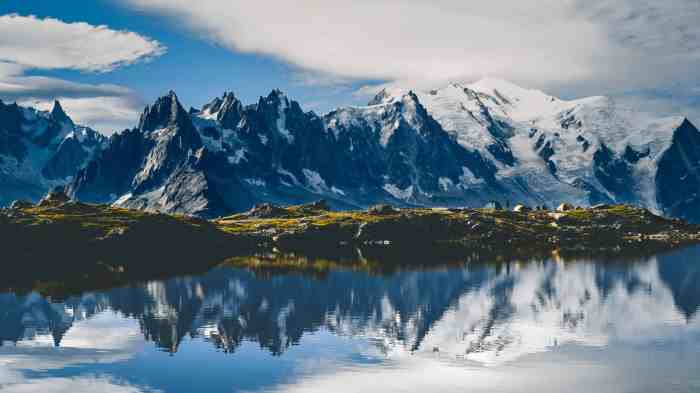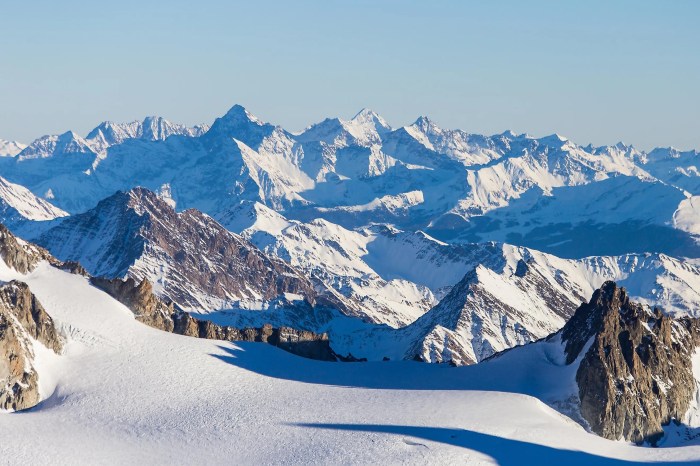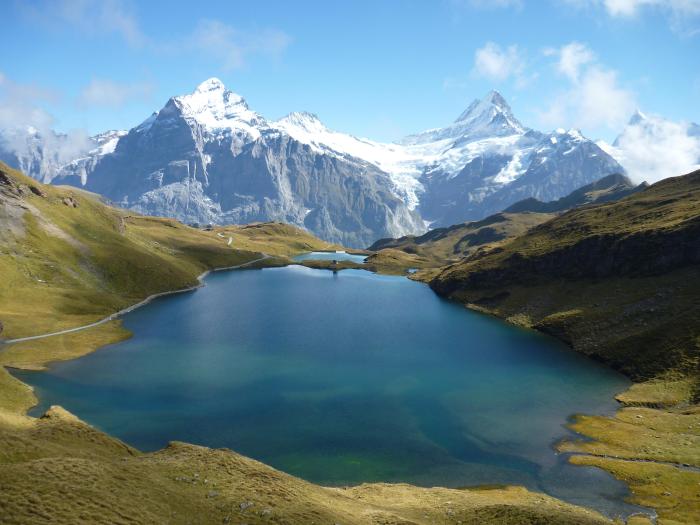The Alps, a breathtaking mountain range that spans across Europe, beckon us with their majestic peaks, verdant valleys, and rich cultural heritage. From their geological origins to their modern-day significance, the Alps offer a captivating narrative that intertwines natural wonders with human history.
Shaped by the forces of plate tectonics and glaciation, the Alps boast an array of geographical features, including towering mountain ranges, pristine lakes, and picturesque valleys. The climate and vegetation vary dramatically with altitude, creating a mosaic of ecosystems that support a diverse range of flora and fauna.
Physical Geography
The Alps are the highest and most extensive mountain range system that lies entirely in Europe, stretching approximately 1,200 kilometers (750 miles) across eight Alpine countries (France, Switzerland, Italy, Monaco, Austria, Germany, Slovenia, and Liechtenstein). The range’s highest peak is Mont Blanc, which rises to an elevation of 4,808 meters (15,774 feet) above sea level.
The Alps were formed by the collision of the African and Eurasian tectonic plates, which began around 30 million years ago. This collision caused the Earth’s crust to buckle and fold, creating the high peaks and deep valleys that characterize the Alps today.
Geological Processes, Alps
The Alps have been shaped by a variety of geological processes, including:
- Plate tectonics: The collision of the African and Eurasian tectonic plates is the primary force that has shaped the Alps. This collision caused the Earth’s crust to buckle and fold, creating the high peaks and deep valleys that characterize the Alps today.
- Glaciation: The Alps have been glaciated multiple times during the past 2 million years. Glaciers have carved out the U-shaped valleys and cirques that are common in the Alps today.
- Erosion: The Alps are constantly being eroded by wind, rain, and ice. This erosion has created the jagged peaks and steep slopes that are characteristic of the Alps today.
Climate and Vegetation
The Alps exhibit a unique climate and vegetation due to their high altitude and location at the convergence of different air masses. These factors result in diverse temperature variations, precipitation patterns, and altitudinal zonation.
Temperature Variations
- Temperatures in the Alps vary significantly with altitude, following the general lapse rate.
- At higher elevations, temperatures are significantly lower, often dropping below freezing point.
- The average temperature in the Alps decreases by about 6.5°C (11.7°F) for every 1,000 meters (3,280 feet) of altitude.
Precipitation Patterns
- The Alps receive abundant precipitation due to their location in the path of moist air masses from the Atlantic Ocean.
- Precipitation varies with altitude, with higher elevations receiving more snowfall and lower elevations experiencing more rainfall.
- The southern slopes of the Alps receive more precipitation than the northern slopes due to the orographic effect.
Altitudinal Zonation
The Alps exhibit distinct altitudinal zones, each with its characteristic vegetation:
- Montane Zone (800-1,800 meters / 2,625-5,905 feet): Lush forests of beech, oak, and fir trees.
- Subalpine Zone (1,800-2,500 meters / 5,905-8,202 feet): Coniferous forests of spruce, fir, and larch trees.
- Alpine Zone (2,500-3,200 meters / 8,202-10,500 feet): Alpine meadows, grasslands, and scattered dwarf shrubs.
- Nival Zone (above 3,200 meters / 10,500 feet): Permanent snow and ice, with little to no vegetation.
Human History and Culture

The Alps have been home to human habitation since prehistoric times, with evidence of settlements dating back to the Neolithic period. Over the centuries, the region has witnessed the rise and fall of numerous civilizations, each leaving its unique mark on the cultural landscape of the Alps.
Today, the Alps are home to a diverse array of cultures, reflecting the region’s rich history. The Alpine region is divided into several countries, including France, Italy, Switzerland, Austria, Germany, and Slovenia, each with its own distinct language, traditions, and architectural styles.
The majestic Alps, with their towering peaks and pristine landscapes, offer a wealth of opportunities for nature enthusiasts. While enjoying the breathtaking scenery, travelers can also embrace sustainable practices by exploring sustainable travel destinations within the region. From eco-friendly hotels to responsible hiking trails, the Alps provide a unique blend of adventure and environmental stewardship, ensuring that future generations can continue to appreciate their grandeur.
Languages
The Alps are home to a diverse array of languages, reflecting the region’s long and complex history. The most widely spoken languages in the Alps include:
- French
- Italian
- German
- Romansh
- Slovene
In addition to these major languages, there are also a number of minority languages spoken in the Alps, including Ladin, Friulian, and Cimbrian.
Traditions
The Alps are home to a rich and diverse array of traditions, many of which have been passed down through generations. These traditions include:
- Traditional music and dance
- Folklore and legends
- Traditional crafts and skills
- Alpine cuisine
These traditions are an important part of the cultural identity of the Alps and continue to be practiced and celebrated by many people in the region.
Architecture
The Alps are home to a variety of architectural styles, reflecting the region’s diverse history and culture. Some of the most common architectural styles in the Alps include:
- Traditional Alpine chalets
- Baroque churches
- Medieval castles
- Modern ski resorts
These architectural styles are a testament to the region’s rich history and continue to shape the built environment of the Alps.
Economic Activities
Traditionally, the Alps have been characterized by a mix of economic activities, including agriculture, forestry, and tourism.
Agriculture
Agriculture has been a mainstay of the Alpine economy for centuries, with farming and grazing practices adapted to the region’s mountainous terrain. Pastoralism, involving the raising of livestock such as cattle, sheep, and goats, has been particularly important, providing meat, dairy products, and wool.
The majestic Alps, with their snow-capped peaks and pristine lakes, offer a breathtaking escape. For those seeking a contrasting experience, the allure of luxury beach resorts beckons. Indulge in sun-kissed shores, crystal-clear waters, and unparalleled pampering. Upon your return to the Alps, the tranquility and grandeur of the mountains will embrace you once more, leaving you with memories that span the extremes of nature’s beauty.
Forestry
The Alps are home to vast forests, which have provided timber and other forest products for centuries. Forestry has been a significant economic activity, with timber used for construction, furniture, and other purposes. In recent years, sustainable forestry practices have become increasingly important.
Tourism
Tourism has emerged as a major economic driver in the Alps, particularly in areas with scenic beauty, winter sports opportunities, and cultural heritage. The region’s natural landscapes, historic towns, and cultural attractions draw millions of visitors each year.
Challenges and Opportunities
The Alps’ economy faces several challenges, including climate change, which is impacting agriculture and tourism. Additionally, the region’s mountainous terrain can limit economic development and infrastructure.
Despite these challenges, the Alps also present opportunities for economic growth. The region’s natural resources, cultural heritage, and tourism potential offer avenues for sustainable economic development. By leveraging these assets and investing in innovation, the Alps can continue to thrive economically.
Environmental Issues

The Alps, a breathtaking mountain range that stretches across Europe, faces a range of environmental challenges that threaten its pristine landscapes and rich biodiversity. Climate change, pollution, and habitat loss pose significant risks to the Alps’ natural environment, requiring urgent action to protect and preserve its ecological integrity.
Climate Change
Climate change is a pressing issue in the Alps, with rising temperatures and altered precipitation patterns having a profound impact on the region’s ecosystems. Warmer temperatures lead to the melting of glaciers and permafrost, which can destabilize slopes and increase the risk of landslides. Changes in precipitation patterns, such as more frequent and intense rainfall, can trigger flooding and erosion, damaging infrastructure and habitats.
Pollution
Pollution from various sources, including tourism, industry, and agriculture, poses a threat to the Alps’ air, water, and soil quality. Air pollution, particularly from vehicle emissions and industrial activities, can contribute to respiratory problems and damage vegetation. Water pollution from agricultural runoff, sewage, and industrial discharges can harm aquatic ecosystems and contaminate drinking water sources. Soil pollution from heavy metals and other contaminants can reduce soil fertility and harm plant growth.
Habitat Loss
Habitat loss is another major environmental issue in the Alps. Urbanization, tourism development, and infrastructure projects can fragment and destroy natural habitats, leading to a decline in biodiversity. Deforestation, particularly for logging and land conversion, can also contribute to habitat loss and soil erosion. The loss of habitats can have far-reaching consequences, disrupting ecological processes and threatening the survival of species.
Tourism and Recreation

Tourism is a major economic driver in the Alps, attracting millions of visitors each year. The region offers a wide range of recreational activities, including skiing, snowboarding, hiking, mountain biking, and rock climbing. These activities provide a significant source of income for local businesses and contribute to the region’s economy.
When embarking on an Alpine adventure, a travel itinerary template can be invaluable. It helps organize your time, ensuring you maximize your experience amidst the breathtaking peaks and pristine valleys of the Alps. From planning hikes to booking accommodations, a well-structured itinerary will guide you through this unforgettable journey.
Types of Recreational Activities
The Alps offer a diverse range of recreational activities for visitors of all ages and interests. Some of the most popular activities include:
- Skiing and snowboarding: The Alps are home to some of the world’s most famous ski resorts, offering a variety of slopes for all levels of skiers and snowboarders.
- Hiking: The Alps offer a vast network of hiking trails, ranging from easy walks to challenging treks. Hikers can enjoy stunning scenery, including towering peaks, lush meadows, and sparkling lakes.
- Mountain biking: The Alps are a mountain biker’s paradise, with trails ranging from gentle slopes to challenging descents. Bikers can explore the region’s forests, mountains, and valleys.
- Rock climbing: The Alps offer some of the world’s best rock climbing, with a variety of routes for climbers of all levels.
Impact of Tourism
While tourism is an important economic driver for the Alps, it also has some negative impacts on the environment and culture. These impacts include:
- Environmental degradation: Tourism can lead to environmental degradation, such as pollution, erosion, and deforestation. The construction of ski resorts and other tourist facilities can also damage the natural environment.
- Cultural change: Tourism can also lead to cultural change, as traditional ways of life are replaced by those that cater to tourists. This can lead to the loss of local customs and traditions.
Final Summary

The Alps have played a pivotal role in human history, serving as a crossroads for trade, migration, and cultural exchange. Today, they continue to attract visitors from around the globe, who come to experience their natural beauty, engage with their vibrant culture, and partake in the myriad recreational opportunities they offer.
As we delve deeper into the realm of the Alps, we will explore their geological origins, climatic patterns, cultural diversity, economic activities, environmental challenges, and the vital role they play in tourism and recreation. Join us on this captivating journey as we uncover the secrets and wonders of this iconic mountain range.
Common Queries: Alps
What is the highest peak in the Alps?
Mont Blanc
What countries are the Alps located in?
France, Italy, Switzerland, Austria, Germany, Slovenia, and Liechtenstein
What is the name of the famous tunnel that runs through the Alps?
Mont Blanc Tunnel